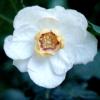NEW |
SINOCALYCANTHUS
chinensis This plant is still extremely rare, having only been discovered in china relatively few years ago. It has quickly established itself as one of my very favourite plants. It first flowered in this country in 1989 in the garden of Roy Lancaster. Deciduous, it is related to Calycanthus and reaching 3m tall, it has large glossy green leaves which turn bright yellow in the autumn. The flowers are absolutely beautiful, being 7cm across and borne singly at the end of the shoots. The outer petals are pure white, with an inner group of yellow ones, white at the base with maroon markings. Sun or shade. |
|
|
|
| x
SINOCALYCALYCANTHUS x raulstonii 'Hartlage Wine' (Sinocalycanthus chinensis x Calycanthus floridus) This cross was made by a student at North Carolina State University in 1991, to flower in 1996. Giving the best of both parents, it produces masses of showy large, smoky wine-red flowers that open widely (almost like a camellia) with a subtle fragrance. It seems to be tolerant of most conditions, flowering equally profusely in sun or shade. |
|
|
|
|
| SORBUS
alnifolia For me, this is a delightfully under-stated sort of tree. Of small or medium stature, the purplish-brown branches are clothed in rather small, roundish strongly veined leaves which are reminiscent of hornbeam. Small clusters of hawthorn-like flowers are freely produced in spring. It is a charming site in autumn when red fruit are held against foliage turning scarlet and orange. |
|
|
|
|
| SORBUS
folgneri Lemon Drop A beautiful but almost unlikely member of this surprising genus. A small tree of graceful arching habit, the small leaves are grey and felted. White flowers in this lovely, rare form are followed by yellow berries. Grafted for younger flowering. |
|
|
|
|
| SORBUS
megalacarpa This amazing small tree has so many unique features that it is difficult to know where to start! The young leaves and buds are bright red and form a "shuttlecock" around the large corymbs of creamy flowers in early spring. These are followed by bunches of small, hard brown fruits (similar to Oak Apples) which last until the next flowers the following spring. The seed came from the beautiful tree at Knightshayes Court, Devon which featured in an article in The Garden. |
|
|
|
|
|
STACHYURUS
chinensis |
|
|
|
|
| STACHYURUS
chinensis 'Celina' Flowering in April, as does all the genus, this amazing selection can have 25-50 soft yellow, cup-shaped flowers per truss which is truly remarkable. |
|
|
|
|
| STACHYURUS
chinensis 'Magpie' This beautiful form has grey green leaves with an irregular creamy white margin and strongly tinged pink. Flowers as the species. It is difficult to grow however - it is so variegated that it does not have much chlorophyll to allow it to produce energy. The problem is in establishment, since the bigger it gets, the stronger and hardier it will become. This has given us trouble before, but so far this year's batch is the best we've had. |
|
|
|
|
| STACHYURUS
praecox The flowers are basically the same as S. chinensis but occur 2 weeks earlier. |
|
|
|
|
| STACHYURUS
praecox var. leucotrichus This impressive form has very large, bright green leaves and chunky flower racemes to go with its very rigid, chunky growth habit. It holds its leaves well into winter too. |
|
|
|
|
| STACHYURUS
praecox 'Mitsuzaki' This vigorous, robust form has been described as "Stachyurus on steroids" crude but effective. The leaves, stems and flowers can be expected to be twice the size of the species. |
|
|
|
|
|
STACHYURUS praecox 'Petra' This is a splendid selection. |
|
|
|
|
| STACHYURUS praecox var. mitsuzakii | |
|
|
|
|
STACHYURUS
salicifolius This is a fabulous form with very narrow leaves. The flowers are typical of the genus. Although we have not yet grown it to maturity, I would expect it to be less vigorous than the norm due to the reduced amount of leaf, particularly when young. Worthy of a special site in the garden to give it a good start. Few only. |
|
|
|
|
| STACHYURUS yunnanensis | |